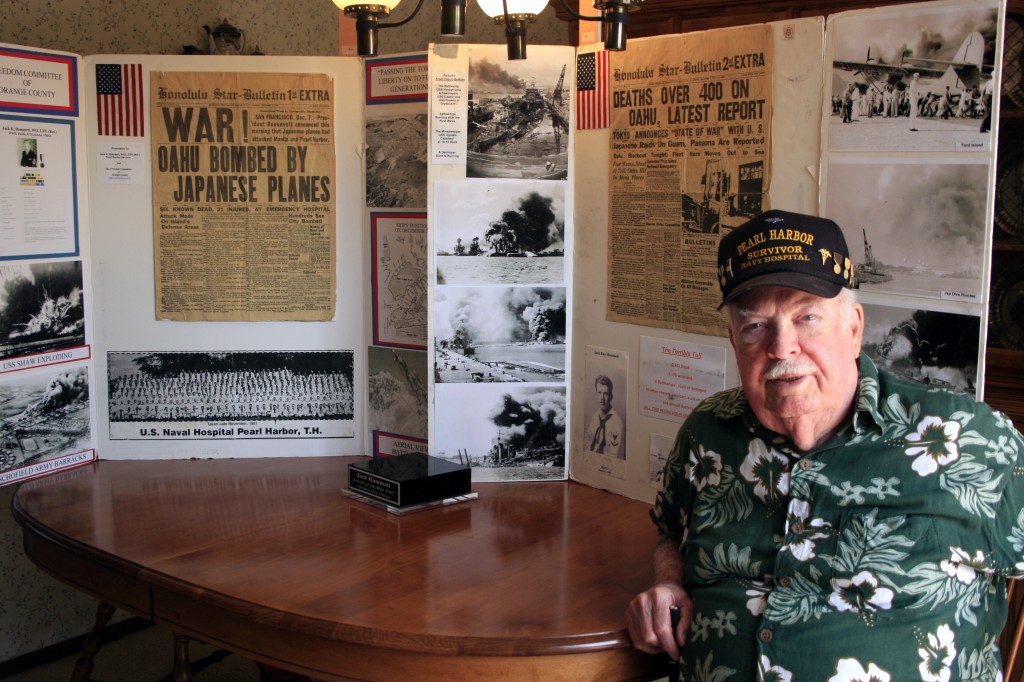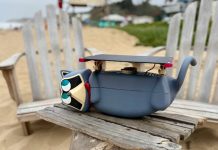
This Fourth of July, a group of local veterans has a special message: Freedom isn’t free.
The Freedom Committee of Orange County delivers this message to schools across Orange County, including Corona del Mar and Newport Harbor high schools and several Newport Beach elementary schools, through first person accounts. The members are a “living history” that students can learn from.
Members of the group are veterans of World War II, Korea and Vietnam and cover all theaters of war.
“Stories of Pearl Harbor, the Dieppe raid, Battle of the Bulge, D-Day, Air battles in the war torn skies of the South Pacific, over Fortress Europe, and even experiences of being Prisoners of War,” are all included from the veterans, according to the committee’s website. Stories about “witnessing the Atom bomb drop, Flying the Hump in the CBI Theater, bombing of the Ploesti Oil fields, and freeing inmates of the German concentration camps.”
Jack Hammett, WWII veteran and Pearl Harbor survivor, founded the group in 1996.
“What does Fourth of July mean to me? It takes me back to my childhood, when I was so enthused with the red, white and blue,” Hammett recalled. “Now, as an adult, a senior adult, and as a veteran, obviously… I’m very patriotic.”
“Fourth of July reminds me of how we started,” he continued. “Our forefathers were fighting for freedom, we’re fighting to defend it.”
Hammett, 93, enlisted in the U.S. Navy in 1937 and was shipped out to San Pedro just one year later. At that point the played the saxophone in the Navy band on the USS Argonne, the flagship of the base force.
In San Pedro, he met his future wife, played in a combo band on the beach, and received medical training as a hospital corpsman.
He got shipped out to the Navy hospital at Pearl Harbor in June of 1940, just four months after getting married. His wife, Mary Jo, came out to Hawaii in April of 1941.
They shared a house with two other couples, about one mile from Waikiki Beach and around 10 miles from Pearl Harbor
“Life was really idyllic,” he recalled.
Until that fateful December day in 1941.
“In the morning, there was this noise that woke us up, explosions,” he said, assuming the Coast Guard was practicing just off shore.
Their landlord knocked on their door and asked for the monthly rent of $35, then, in a matter-of-fact tone, told them “the Japanese are bombing Pearl Harbor.”
He quickly got dressed and kissed his wife goodbye. In the taxi ride down to the base, bombs were being dropped all around them. A cab in front of him was hit, killing a friend of his from the hospital.
“Anything that was moving they were strafing,” he recalled.
He arrived at the hospital, which was already overflowing with the dead and injured, and worked 72 hours straight. He would work triage for four hours then four hours identifying bodies.
He remembers small details from that day and those few intense days that followed: The taste of a baloney sandwich, the only food he actually remembers eating. A break around 4 p.m. and looking over the harbor, seeing the USS Nevada run aground and the USS Oklahoma rolled over and upside down like a beached whale. Scrambling down into the pitch black basement, where bodies were being stored, when he heard an air raid signal and “all hell broke loose with anti-aircraft fire.” Realizing where he was and smelling death all around him and then tumbling a bit as he felt his way back up the stairs after it went quiet.
As a married man, he eventually was allowed a break to go and see his wife, who he had heard no news of her condition. She was safe and promptly took his no longer white uniform and sent him to bed. He slept for a few hours before going back.
“Freedom is not free,” Hammett said. “The price is tremendous.”
Pearl Harbor was a high price to pay: 2,403 people were killed, 1,178 were wounded, 18 ships were sunk or damaged, and 165 aircraft completely destroyed., Hammett recounted, all in less than two hours.
“That’s a lot of carnage in a short period of time,” Hammett explained.
He continued his military career and worked his way up the ranks, eventually reaching Warrant Officer, One (WO1) in the Navy. His active duty covered both WWII and the Korean conflict, and his campaigns included Pearl Harbor, D-Day Normandy, North Africa, and Atlantic Anti-Submarine action. He received a number of awards and medals and retired in 1959.
The Freedom Committee began after the Army started putting together World War II Commemorative Committees across the country in 1991. Hammett got about 30 guys together and would go around speaking to groups. By 1995 the federal program was over, but Hammett and four others wanted to continue, so the Freedom Committee of Orange County was born.
Now, the committee has more than 100 members, all military veterans, and 46 associate members, non-military supporters.
They are there to support the teachers and their lesson plans, he explained. Students get to learn to appreciate what they read in their textbooks.
The vets get something out of the relationship with the students as well.
“(We get) self-satisfaction that (we’re) doing the best that (we) can to alert the student that freedom is not free,” Hammett said, and Americans should respect the men and women haven’t come back.
“The whole idea is passing the torch of liberty onto future generations,” Hammett said. “We’re living memorabilia.”
The committee runs on donations by its members and supporters. The group is apolitical and have no religious affiliations. For more information, visit fc-oc.org.




